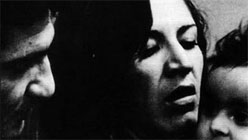It features the kind of raw acting and stark narrative that you find in Five Easy Pieces or Midnight Cowboy, and like those movies, Brick and Mirror is festooned with characters who have sex, ambition and regret on their mind. Anger, too. A woman leaves a baby in the back seat of a taxi, and the cab driver — a bachelor in his 30s — is forced to take in the crying, needy infant when he’s at a low point in his life. That’s how Brick and Mirror begins, and it never lets up. What makes the drama even more alluring: It was filmed in 1965, in Tehran, by a director (Ebrahim Golestan) who earned the title, “the father of Iranian new wave cinema.”
Brick and Mirror, which was banned in Iran, is screening this Saturday as part of the Iranian Film Festival, an annual San Francisco event that offers poignant looks at Iran’s history and — more importantly — Iran’s present. Iranian rap music? You can see it in the new short documentary, Bahram: An Iranian Rapper, which is making its U.S. premier on Saturday night. A woman bus driver in Tehran who reserves her bus’ front section for women? You can see that in Masculin, Feminin, a documentary that screens on Sunday. In the film, driver Farahnaz Shiri startles a man boarding the front steps by saying, “Sir, enter the rear door!” “I am astonished,” says one man sitting in the back of Shiri’s bus, while a woman passenger tells filmmaker Sadaf Foroughi that the vehicular privilege “doesn’t change anything; we need fundamental change” for women in Iran.

Masculin, Feminin
Many of these movies are screening publicly in the U.S. for the first time. Crossroads of Civilization, an historical documentary about ancient Iran that was produced by Sir David Frost in 1976, is getting its world premiere on Sunday. The eight-part series was never shown in its time because events leading to Iran’s 1979 revolution “shelved the production,” says festival director Saeed Shafa. Now in its fourth year, the Iranian Film Festival is the only independent festival of its kind in the United States, Shafa says. (The Festival of Films from Iran, held annually at Chicago’s Gene Siskel Film Center, and similar festivals rely on the Iranian government for their programming.) Because of his festival’s unique status, Shafa gets submissions from around the world, including Iran. Shafa, who left his native Iran for the United States in 1972 (when he enrolled at San Francisco State), started the Iranian Film Festival four years ago to bridge an information gap. The mainstream media emphasizes Iran’s political, governmental and religious underpinnings, so other dimensions of Iranian society — especially its culture — go missing.
“The people of Iran are completely different from what we see on TV (news),” says Shafa, who also founded the Tiburon International Film Festival in 2002 and the Petaluma International Film Festival in 2009. “There’s a big difference between them and the government, and people shouldn’t judge them by their government.”



